It's been said that: "one good turn deserves another". In a game, when you have a big turn, you are making it more difficult for your opponent to respond in kind. If you play a big threat and are close to a win, then your opponent not only needs timely removal, but also needs a threat of his own to turn the tables. But what if we change up the phrase a bit. What if instead of 'one good turn' we made our own 'turn one good'?
For the purpose of this article let's assume you aren't winning or losing on turn one. How do you use it? What is the best thing your deck can do? The first turn is often written off. People don't take it seriously or don't take full advantage of it. Let's look at some typical turn one plays in Commander and evaluate their strategic potential.
LAND, GO.
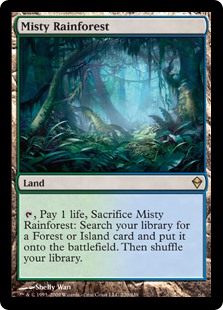
This is by far the most common opening that I see. The 'big mana' nature of the format unfairly slants people away from making cheap plays that are less powerful. Using your first turn to play a ETB tapped land is what I consider to be the standard play in the format. You give up the ability to present any interaction on this turn to make it easier to interact on future turns by fixing your mana. This is almost always telegraphed to your opponent, especially through body language. Some players tank on their mulligan choice, eventually keep and do nothing for three turns, slouched in their chair. Don't...do that. If you don't care about your posture at least care about posing a threat to your opponent. Make them think you have a game plan, a good hand, a card to play. This is the big difference between a tapped land and a fetch land. It presents potential interaction. You will actually need to have it
in order for your opponent to respect it. So play lands that enter the battlefield untapped and play cards to take advantage of that. If your opponent is slumped in his chair throwing tap lands at the table go on the aggressive (or disruptive).
ROCKS.
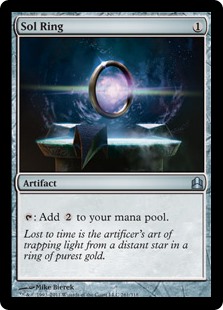
This is a very strong opening. I don't just mean Sol Ring and friends. Expedition Map, Wayfarer's Bauble, and various spellbombs are all good openings. These are enablers, they let you get on to bigger and better things. They speed you up, change the angle of attack, or show off your theme. I titled this category to refer to any old random artifact, but it is slightly more inclusive than that. The point here is that you are doing
something that isn't necessarily easy to interact with.
MANA DORKS
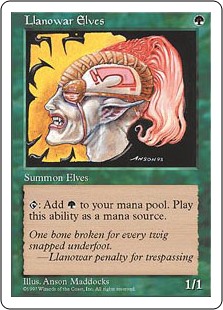
I don't support playing mana dudes in the general case. They are so bad against board sweepers (and board sweepers are so common) that you need a special reason to be playing them. I consider one drop mana dudes to be 'smoke' cards. They indicate fire. Their deck is chock full of juicy three drops like Birthing Pod, they have tribal synergies, their general is typically a three drop or a voltron candidate, maybe they're packing anthem or overrun effects. This is a weaker opening than an artifact because it is subject to more removal, but it should tell you something about your opponent's deck. There is a reason that they are playing ostensibly inferior cards: they either need them or can take advantage of them.
DISRUPTION
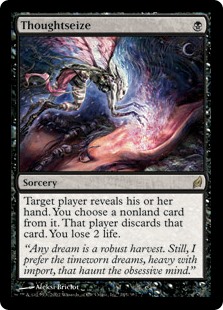
This is my personal favorite way to open a game. I happen to have the advantage of playing against some greedy opponents. They lean heavy on their Kodama's Reach or their early Brainstorm. When you take away this key resource it becomes abundantly clear that they should have mulliganed. Unfortunately, a lot of players just aren't skilled enough to evaluate their opening hands in conjunction with an opponent's typical openings. Playing against me you learn to do this quickly. Losing isn't always bad, but losing in a painful and shameful way because of a mistake you made before the game even began really seems to grind peoples gears. My advice is this: "turn fear against the fearful." Then your playgroup will be the ones having Duress-induced nightmares instead of you.
DRAW FIXERS

This is a pretty decent way to open a game. Fixing your cards is just like fixing your mana. You give up tempo now so that later you can have the right pieces in place to capitalize. The trouble with this is Preordain, Ponder, and Brainstorm are some of the hardest cards in the game to play correctly. Making bad decisions on how and when to play them can cost you the game. Not to mention that you actually have to make the best possible decision while
resolving the spell. As I mentioned above, cards like this tend to put greedy people on the edge of terrible decisions. Greedy keeps are only one notch better than outright awful keeps and the line between them is sometimes blurry. With all that behind us, I play the bricks off of this card and others like it. It is a fantastic top deck and it glues together your early game. It finds what you need and that is what you really needed all along. It is your best card and the card you have been looking for.
AGGRO
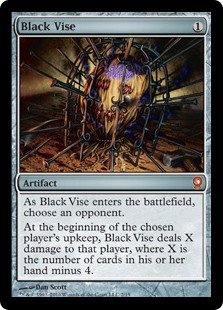
This usually means playing a pint-sized beater. Some of them are good. Some of them are embarrassingly bad. I can recommend some if you are feeling frisky, but I like to stay away from stuff like this. It is good, but it just isn't going to be good
enough against the best decks. Forty life is a lot to tackle without backup. As I have said before Aggro isn't really a thing in this format. As I have also said, Aggro-Control decks are the best of the 'fair' decks. Getting down a few attackers and backing them up with counterspells and land destruction is an easy way to steal a win. The faster you can set this up the better so start early.
The main lesson here is to think hard about what your deck's first turn looks like. What is the best thing you can be doing? What happens on average? What are you vulnerable to? What can you take advantage of?
Final thought: According to Husky Starcraft, "Every game has an early game, but not every game has a late game." Put them to the sword on turn one and you might just save yourself some grief later.
GG

No comments:
Post a Comment